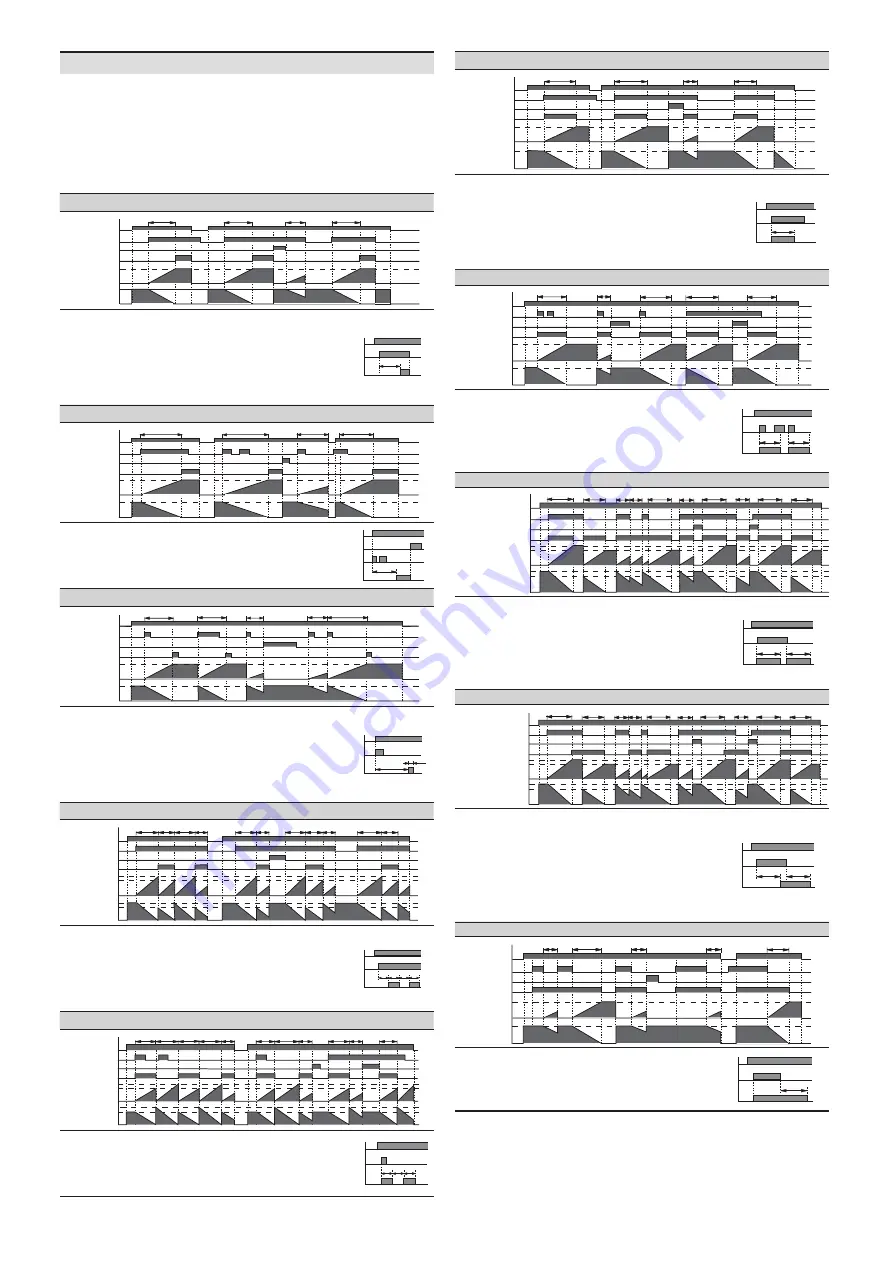
-|Transparent Guide|-
Output Operation Mode
■
LE4S
The timing charts are under the supplying power.
Initial status: UP mode - display value 0, output OFF
DOWN mode - displays the setting time, output OFF
•
T, T.on, T.off : setting time / T.out : One-shot output time (range: 0.01 to 99.99 sec)
•
T.on, T.off : individual setting available
•
T, T.on, T.off >
Ta
•
T = T1 + T2 / T = Ta + Tb + Tc
OND
POWER
START
RESET
RELAY OUT
Setting time
Setting time
0
0
UP
DOWN
T
T
①
②
③
④
T
Ta
1. START signal: time starts during ON state
2. Position ① - progressing time = setting time →
Output: ON, display value: Hold
3. Position ② - RESET signal: ON → Display value and output:
return to the initial status
4. Position ③ - START signal: ON → RESET signal: OFF, starting the
operation of no. 1
5. Position ④ - START signal: OFF → Display value and output:
return to the initial status
POWER
START
RELAY OUT
T
OND.1
POWER
START
RESET
RELAY OUT
Setting time
Setting time
0
0
UP
DOWN
T
T
①
②
③
T
Ta
1. START signal: ON → Time starts
2. Position ① - progressing time = setting time →
Output: ON, display value: Hold
3. Position ② - Recognizes the first START signal
4. Position ③ - RESET signal: ON → Display value and output:
return to the initial status
POWER
START
RESET
RELAY OUT
T
OND.2
POWER
START
RESET
RELAY OUT
Setting time
Setting time
0
0
UP
DOWN
T
T
①
②
T
Ta
Ta
1. START signal: ON → Time starts
2. Position ① - progressing time = setting time →
Output: ON (during T.out) and OFF,
display value: Hold
3. RESET signal: ON → Display value and output: return to the
initial status
4. Position ② - START signal: ON during progressing the time,
Progressing time: return to the initial status and
progress again.
T
T.out
POWER
START
RELAY OUT
FLK
POWER
START
RESET
RELAY OUT
T.off
T.off
T.on
T.on
0
0
UP
DOWN
T.off
T.off
T.off
T.off
T.off
T.on
T.on
T.on
Ta
Ta
Ta
1. START signal: ON during the output: repeating OFF (during T.off ),
ON (during T.on)
2. RESET signal: ON → Display value and output: return to the
initial status
3. START signal: ON status, RESET signal: OFF → Starts the
operation of no. 1
4. START signal: OFF → Display value and output: return to the
initial status
T.offT.onT.off T.on
POWER
START
RELAY OUT
FLK.1
POWER
START
RESET
RELAY OUT
T.off
T.off
T.on
T.on
0
0
UP
DOWN
①
T.off
T.off
T.off
T.on
T.on
T.on
T.on
T.on
Ta
Ta
Ta
1. START signal: ON → Output: repeating ON (during T.on),
OFF (during T.off)
2. Position ① - Recognizes the first START signal
3. RESET signal: ON → Display value and output: return to the
initial status. But, when the START signal is
ON, progress again.
POWER
START
RELAY OUT
T.on T.off T.on
INT
POWER
START
RESET
RELAY OUT
Setting time
Setting time
0
0
UP
DOWN
T
T
①
②
T
Ta
1. START signal: ON, instantly output: ON and time starts
2. Progressing time = setting time → Output: OFF,
display value: Hold
3. Position ① - RESET signal: ON → Display value and output:
return to the initial status
4. START signal: ON status, RESET signal: OFF →
Starts the operation of no. 1
5. Position ② - START signal: OFF → Display value and output:
return to the initial status
POWER
START
RELAY OUT
T
INT.1
POWER
START
RESET
RELAY OUT
Setting time
Setting time
0
0
UP
DOWN
T
T
T
T
Ta
①
②
1. START signal: ON, instantly output: ON and time starts
2. Progressing time = setting time → Output: OFF,
display value: Hold
3. Position ① - Recognizes the first START signal
4. Progressing time = setting time → START signal: ON, instantly
output: ON, initializing time and progress
5. Position ② - RESET signal: ON → Display value and output:
return to the initial status
POWER
START
RELAY OUT
T
T
NFD
POWER
START
RESET
RELAY OUT
ON Delay
ON Delay
OFF Delay
OFF Delay
0
0
UP
DOWN
①
②
T.off
T.off
T.off
T.on
T.on
T.on
Ta
Ta
Ta Ta
Setting time
Setting time
1. START signal: ON → Output: ON (during T.on) - ON Delay,
START signal: OFF → Output: OFF (during T.off) - OFF Delay
2. Position ① - START signal: repeatedly input (within the setting
time) → Output: ON, display value: return to initial
status
3. Position ② - RESET signal: ON → Display value and output:
return to the initial status
START signal: ON status, RESET signal: OFF →
ON Delay
POWER
START
RELAY OUT
T.on
T.off
NFD.1
POWER
START
RESET
RELAY OUT
ON Delay
ON Delay
OFF Delay
OFF Delay
0
0
UP
DOWN
①
②
T.off
T.off
T.off
T.on
T.on
T.on
Ta
Ta
Ta Ta
Setting time
Setting time
1. START signal: ON → Time starts,
Progressing time = T.on → Output: ON (ON Delay),
START signal: OFF → T.off: output ON (OFF Delay)
2. Position ① - START signal: ON → OFF (within the setting time)
→ Output: ON, display value: return to initial status
START signal: OFF → ON (within the setting time)
→ Output: OFF, display value: return to initial status
3. Position ②: RESET signal: ON → Display value and output:
return to the initial status
START signal: ON status, RESET signal: OFF →
ON Delay
POWER
START
RELAY OUT
T.on
T.off
OFD
POWER
START
RESET
RELAY OUT
0
0
UP
DOWN
T
T
Ta
Ta
Ta
Setting time
Setting time
1. START signal: ON → Output: maintains ON state
2. START signal: OFF → Time starts
Progressing time = setting time → Output: OFF,
display value: Hold
3. RESET signal: ON → Display value and output: return to the
initial status
POWER
START
RELAY OUT
T
























